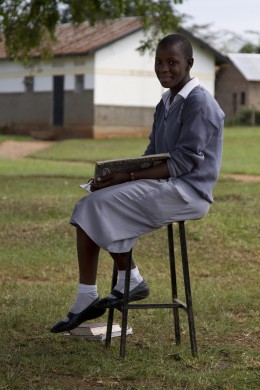
We can’t treat our way out of the HIV/AIDS epidemic, despite the advent of critical life-saving drugs. We must, as HIV/AIDS experts note, also “turn off the tap” of new infections, particularly among the most vulnerable.
For this reason, Creative Associates International welcomes the 2013 World AIDS Day focus of improving teens’ access to HIV prevention (and to treatment and care services.) Adolescents between the ages of 10 and 19 remain among the most at-risk groups for contracting HIV, particularly in Sub-Saharan Africa.
This happens for many reasons: Clinics don’t offer youth-friendly or confidential services, teens live far from health access points, sexual violence targets girls and women. In addition, adolescent girls often drop out of school earlier and face economic vulnerabilities, driving up their risk. The list goes on.
But this World AIDS Day we celebrate some good news for teens: Efforts from Ministries of Health and Education, civil society and firms like Creative have contributed to encouraging trends in improved HIV prevention statistics and behaviors.
According to the newly-released UNAIDS Report on the Global AIDS Epidemic 2013, HIV prevalence (the proportion of people who are living with HIV within the whole population) among young people ages 15-24 in Sub-Saharan Africa fell by 42 percent from 2001 to 2012.
Knowledge about key HIV prevention behaviors continues to rise among adolescents, as does the proportion of teens who have been tested for HIV. Furthermore, young people are increasingly reporting reducing their number of sexual partners and, when they do have sex, using a condom to protect themselves.
Creative is proud of its rich history in specifically targeting adolescents with evidence-based, tailored programs that reach teens with messages and services that resonate with them. To date, we have managed more than 20 projects with HIV components across the globe, many of which use schools and education systems as platforms for reaching young people.
Not only does this work provide key HIV prevention strategies, but also address structural drivers for the disease. A few examples we’re proud of include:
- The Zambia Read to Succeed Program (RTS), which helps teachers offer youth-friendly approaches to HIV prevention and life skills education, particularly for girls.
- The Nigeria Northern Education Initiative (NEI), which works with communities to help develop social and economic support structures for orphans and vulnerable children, some of whom may have lost a parent from AIDS-related causes.
- The UNITY Project in Uganda, which partnered with Uganda’s Straight Talk Foundation to engage parents and teens on tough topics, including HIV prevention, sexual health and life skills.
These projects have changed lives by giving teenagers the support, information and resources they need to stay healthy. But they’re not enough. Creative remains committed to do more to address the HIV needs of young people in 2013, for World AIDS Day and beyond.
Key challenges still persist for adolescent HIV prevention, care and treatment despite the gains we’ve seen during the past decade. (Read about Building an AIDS-free generation here)
More than 2 million young adults ages 10-19 are living with HIV, and that age group is the only one in which AIDS deaths rose between 2001 and 2012, according to the UNAIDS report.
Adolescent girls remain as vulnerable as ever and stigma against people living with HIV is stubbornly entrenched in some places.
Creative keeps these realities in mind as we continually strive to ensure our programs are youth-friendly, holistic and provide critical HIV services globally, no matter the platform or location.
We continue to implement vital education and community mobilization efforts that target teens for HIV prevention, in conjunction with the effective biomedical HIV prevention solutions being rolled out across the globe. These include the scale-up of prevention of mother-to-child transmission (PMTCT) services for pregnant moms with HIV.
We encourage you to watch out for more exciting HIV programming developments in 2014 from Creative and its partners, many of which will fully direct our passion and expertise towards meeting the needs of young people in HIV prevention.
Sara Melillo is an Associate for Health in Creative’s Education for Development Division.